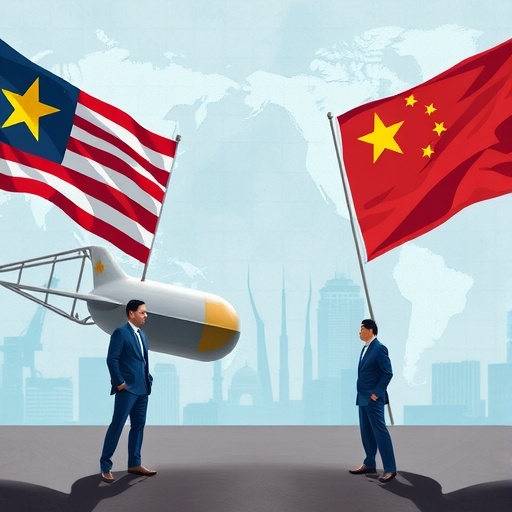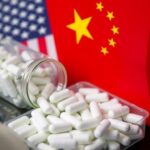US-China Talks Heat Up: Easing Rare Earth Controls and Battling Fentanyl Crisis in Trade Negotiations
In a surprising pivot amid escalating global tensions, high-level US-China talks have zeroed in on easing China’s tight Rare Earth Controls while forging a united front against the devastating Fentanyl Crisis. This development, revealed during recent diplomatic exchanges in Geneva, signals a potential thaw in bilateral relations, blending economic incentives with urgent humanitarian concerns under the umbrella of broader US-China Talks.
The discussions, which unfolded last week, mark a rare instance of cooperation between the world’s two largest economies on issues that have long strained their partnership. US officials, speaking on condition of anonymity, described the talks as “productive and pragmatic,” highlighting China’s willingness to revisit export restrictions on rare earth minerals—critical components in everything from electric vehicles to military hardware. At the same time, both sides pledged to intensify efforts to curb the flow of fentanyl precursors from China, which the US Centers for Disease Control and Prevention (CDC) links to over 70,000 overdose deaths annually in the United States.
This dual-track approach comes at a time when supply chain vulnerabilities and public health emergencies are pushing nations toward collaboration, even as trade wars linger in the background. With the global demand for rare earths projected to surge by 7% annually through 2030 according to the International Energy Agency (IEA), and the opioid epidemic costing the US economy an estimated $1.5 trillion yearly, the stakes couldn’t be higher.
Rare Earth Controls: Unlocking a Strategic Bottleneck
China’s dominance in the rare earth market has been a flashpoint in international trade for years, controlling over 80% of global production and 90% of processing capacity, per a 2023 report from the US Geological Survey. The country’s Rare Earth Controls, implemented through export quotas and licensing requirements, were tightened in response to US tariffs during the Trump-era trade war, exacerbating shortages that hiked prices by up to 50% for elements like neodymium and dysprosium.
During the latest US-China Talks, representatives from the US Department of Commerce and China’s Ministry of Commerce delved into proposals for gradual liberalization. Sources familiar with the negotiations indicate that Beijing floated the idea of increasing export quotas by 20% over the next two years, conditional on US commitments to invest in joint mining ventures outside China. “This isn’t just about minerals; it’s about securing the future of clean energy and defense technologies,” said Dr. Elena Vasquez, a senior analyst at the Brookings Institution, in an interview with Reuters.
The implications are profound. Rare earths are indispensable for manufacturing high-performance magnets used in wind turbines, EV batteries, and fighter jets. The US, which imports 100% of its rare earths from China, has been scrambling to diversify sources, with initiatives like the Defense Production Act funneling $200 million into domestic extraction. Yet, experts warn that without easing Rare Earth Controls, global green transitions could stall, potentially delaying net-zero goals by decades.
Historical context underscores the urgency. In 2010, China briefly cut off rare earth exports to Japan amid a territorial dispute, causing worldwide price spikes and prompting the US to file a World Trade Organization complaint. Today’s talks aim to avoid such disruptions, with US Trade Representative Katherine Tai reportedly emphasizing “mutual benefit” in her opening remarks. Chinese state media, via Xinhua, echoed this sentiment, stating that “cooperation on critical resources fosters stability in an uncertain world.”
Fentanyl Crisis: From Precursor Crackdowns to Cross-Border Collaboration
Shifting gears to the humanitarian front, the Fentanyl Crisis emerged as a cornerstone of the US-China Talks, with both nations acknowledging the synthetic opioid’s role as the deadliest drug in American history. The Drug Enforcement Administration (DEA) reports that fentanyl, often laced into counterfeit pills, was involved in 107,000 US overdose deaths in 2023 alone—a 7% increase from the previous year. Much of the raw materials, including precursor chemicals like 4-anilino-N-phenethylpiperidine (ANPP), originate from Chinese manufacturers before being shipped to Mexican cartels for final synthesis.
In a bold move, Chinese officials committed to enhancing regulatory oversight on these chemicals, including real-time tracking via a new bilateral database. US Secretary of State Antony Blinken, in a post-talks briefing, praised the pledge: “China’s cooperation could save countless lives, and we’re prepared to support their enforcement efforts with technical expertise.” This builds on prior actions; since 2019, Beijing has classified fentanyl as a controlled substance and shut down over 200 illicit labs, according to the Chinese National Narcotics Control Commission.
Yet, challenges persist. A 2024 UN Office on Drugs and Crime report highlights how traffickers exploit regulatory gaps, with online sales of precursors surging 300% during the pandemic. The talks also explored joint training programs for customs agents and intelligence-sharing protocols, potentially modeled after the US-China counternarcotics working group established in 2020. Public health advocates, including the Partnership for a Drug-Free America, hailed the discussions as a “game-changer,” estimating that effective precursor controls could reduce US fentanyl supply by 40% within five years.
Personal stories amplify the crisis’s toll. In Ohio, a state ravaged by opioids, families like that of 28-year-old victim Sarah Jenkins have lobbied Washington for action. “Every precursor stopped in China is a mother who doesn’t lose her child,” Jenkins’ mother told CNN, underscoring the human cost driving these diplomatic overtures.
Trade Negotiation Framework: Weaving Economics and Security
These focused dialogues on Rare Earth Controls and the Fentanyl Crisis are embedded within a expansive trade negotiation framework that spans tariffs, intellectual property, and agricultural exports. Launched under the Biden administration’s “strategic competition” doctrine, the framework seeks to de-risk supply chains without full decoupling—a strategy outlined in the 2022 US National Security Strategy.
Key concessions floated include China’s potential rollback of retaliatory tariffs on US soybeans and pork, which have cost American farmers $27 billion since 2018, per the American Farm Bureau Federation. In return, the US might ease restrictions on semiconductor exports to non-military Chinese firms. Economists like those at the Peterson Institute for International Economics project that successful US-China Talks could boost bilateral trade by $100 billion annually, stabilizing global markets amid inflation pressures.
Geopolitical undercurrents add layers of complexity. With the US Inflation Reduction Act subsidizing domestic mineral processing to the tune of $369 billion, and China’s Belt and Road Initiative expanding rare earth influence in Africa, both powers are jockeying for long-term leverage. A leaked diplomatic cable, cited by The Wall Street Journal, reveals US concerns over China’s alliances with Russia and Iran, suggesting that fentanyl and rare earth pacts could serve as confidence-building measures.
- Economic Data Point: US rare earth imports from China dropped 20% in 2023 due to controls, per Commerce Department figures.
- Health Statistic: Fentanyl seizures at US borders hit 27,000 pounds in 2023, a record high, according to Customs and Border Protection.
- Trade Volume: US-China goods trade reached $690 billion in 2023, despite ongoing frictions.
Stakeholders from industry are optimistic. The Rare Earth Industry Association urged swift action, warning that “delays in easing controls could cripple EV production timelines.” On the fentanyl side, pharmaceutical leaders like Pfizer have offered to collaborate on alternative pain management solutions, tying health diplomacy to innovation.
Expert Insights: Balancing Optimism with Caution
As news of the US-China Talks spreads, experts are parsing the fine print. “This is a pragmatic step forward, but trust remains fragile,” noted Paul Triolo, head of Asia policy at Eurasia Group. He points to past breakdowns, like the 2019 Phase One trade deal’s unfulfilled purchase commitments, as cautionary tales. Triolo predicts a 60% chance of interim agreements on rare earths by year’s end, but warns that domestic politics—US midterm pressures and China’s economic slowdown—could derail progress.
On the Fentanyl Crisis, Dr. Wang Mei, a Beijing-based toxicologist, emphasized enforcement hurdles: “China has the laws, but implementation requires international pressure and resources.” A panel discussion hosted by the Council on Foreign Relations featured US Ambassador to the UN Linda Thomas-Greenfield, who stated, “Diplomacy isn’t zero-sum; addressing shared threats like fentanyl strengthens us all.”
Quantitative models support guarded hope. A simulation by the RAND Corporation suggests that joint rare earth initiatives could cut US dependency on China by 30% by 2030, while fentanyl controls might avert 50,000 deaths over the same period. However, skeptics like former trade negotiator Robert Lighthizer argue for tougher stances, calling the talks “symbolic without verifiable metrics.”
Environmental angles also factor in. Rare earth mining’s toxic legacy—China’s Bayan Obo site has contaminated groundwater for decades—prompts calls for sustainable practices in any deal. NGOs like Greenpeace advocate for “green clauses” in agreements, ensuring that eased Rare Earth Controls don’t exacerbate ecological damage.
Path Forward: Implications for Global Stability
Looking ahead, the outcomes of these US-China Talks could reshape international dynamics. Successful easing of Rare Earth Controls might spur a new era of mineral diplomacy, with third countries like Australia and Vietnam benefiting from diversified supply chains. On the Fentanyl Crisis, enhanced collaboration could extend to multilateral forums like the UN Commission on Narcotic Drugs, pressuring Mexico and India to align efforts.
Next steps include follow-up virtual meetings in November and a potential in-person summit in 2025, per State Department schedules. Investors are watching closely; rare earth stocks like MP Materials surged 5% on news of the talks, while biotech firms eye funding for opioid alternatives. Ultimately, these negotiations underscore a truth in modern geopolitics: shared vulnerabilities can bridge divides, paving the way for a more resilient global order. As tensions simmer in the South China Sea and Taiwan Strait, such cooperative breakthroughs offer a glimmer of hope for de-escalation.
In the words of a senior Chinese diplomat, quoted anonymously in South China Morning Post, “Progress on rare earths and fentanyl shows that dialogue works when both sides prioritize outcomes over ideology.” With billions in economic value and countless lives hanging in the balance, the world awaits the next chapter in this pivotal partnership.








